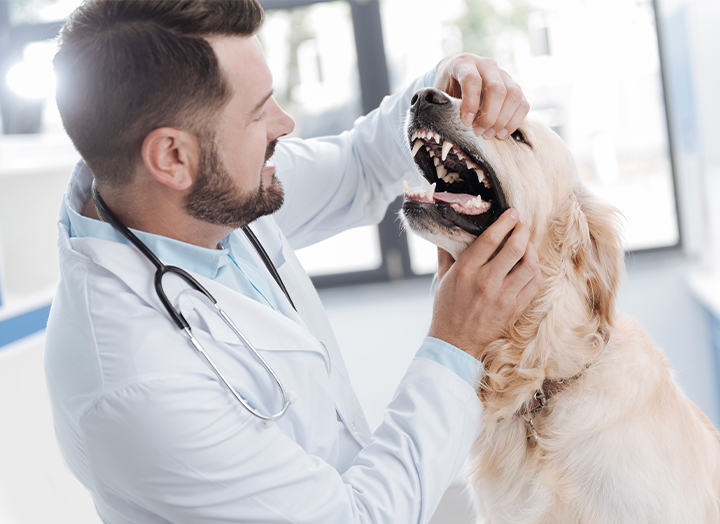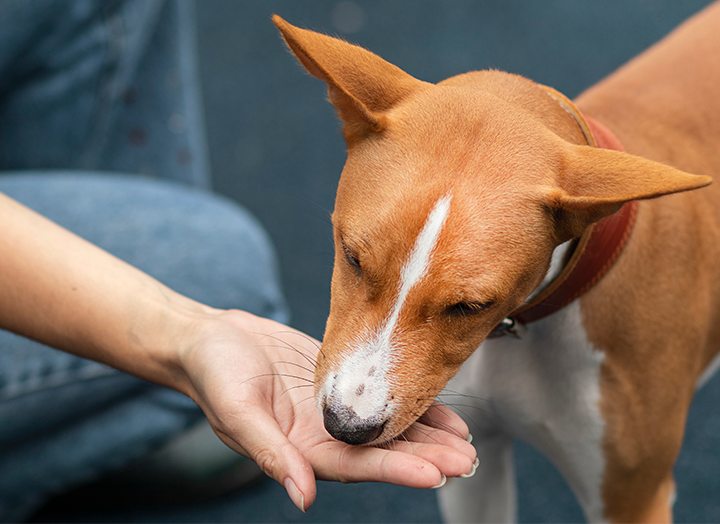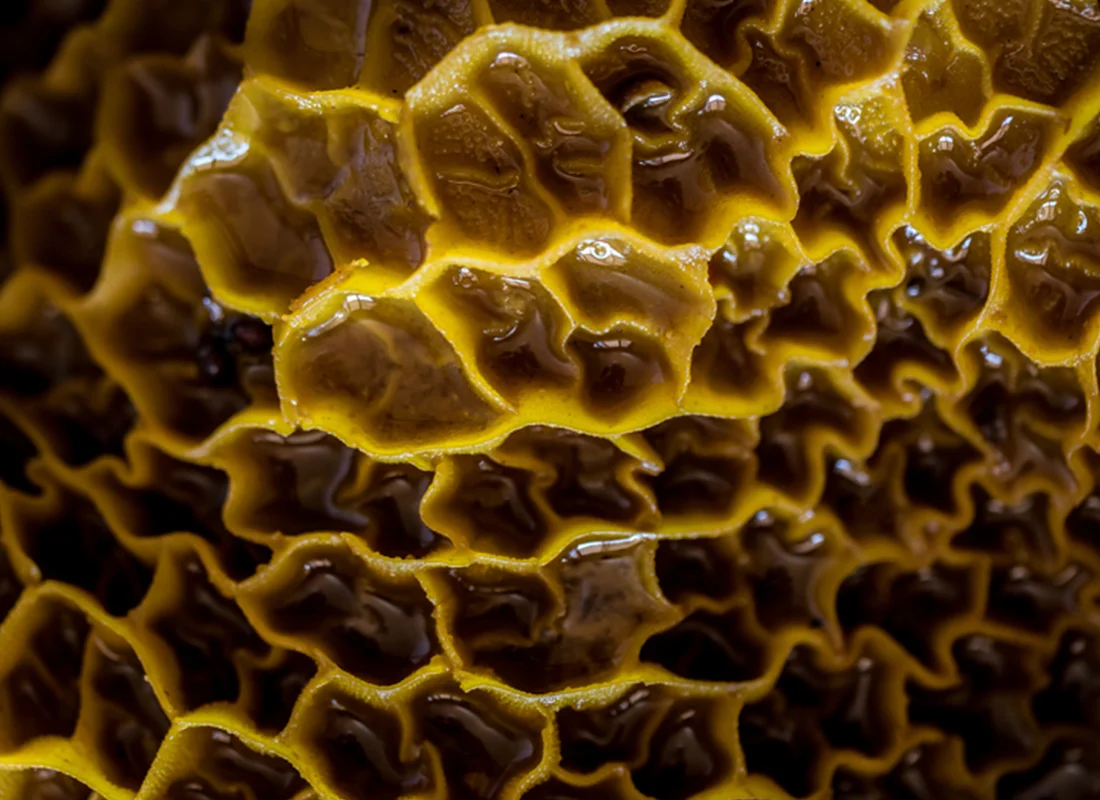[vc_row][vc_column][vc_column_text css=””]
Just like us, dogs can also find themselves unexpectedly uninterested in their meals, which can be concerning since they typically approach mealtimes with excitement.
However, before allowing concern and worry to take over, let’s explore the underlying reasons behind their lack of appetite. Today we will delve into the diverse factors contributing to a dog’s reduced eating habits, while also providing valuable guidance on determining when it’s appropriate to seek advice from a veterinarian.
[/vc_column_text][/vc_column][/vc_row][vc_row][vc_column][vc_row_inner content_placement=”middle”][vc_column_inner width=”1/2″][vc_column_text css=””]
Why isn’t my dog eating his food?
Health issues
A decrease in appetite or a dog not eating food can often signal an underlying health issue. From minor concerns to more serious conditions, your dog’s body could be communicating distress in this way. Common health issues that might lead to a decreased appetite include dental problems, gastrointestinal disorders, infections, kidney disease, and even certain types of cancer. If your dog’s lack of appetite persists, it’s crucial to consult a veterinarian to rule out any potential medical issues.
Stress and anxiety
Dogs are sensitive creatures, and changes in their environment or routine can cause stress and anxiety. These emotions can directly impact their appetite and lead to a dog not eating food. Major life events like moving to a new home, the introduction of a new family member (human or animal), or even loud noises from construction can contribute to stress-induced appetite loss. Providing a secure and calm environment for your dog, along with positive reinforcement, can help alleviate these feelings and encourage eating.
Recent vaccinations or medications
Certain vaccines and medications can temporarily affect a dog’s appetite. While this is usually a short-term concern, it’s important to observe whether the loss of appetite persists for more than a day or two. If it does, consult your veterinarian to ensure that your dog’s reaction to the medication or vaccine is within the expected range.[/vc_column_text][/vc_column_inner][/vc_row_inner][vc_row_inner content_placement=”middle”][vc_column_inner width=”1/2″][vc_column_text css=””]
Dietary changes
Dogs, like humans, can be creatures of habit. Introducing a new type of dog food, sudden changes in diet, or an abrupt transition from home-cooked meals to commercial kibble might lead to a reluctance to eat. When altering your dog’s diet, make gradual adjustments and monitor their response. Also, consider the possibility of allergies or intolerances to certain ingredients in the new food.
Age-related changes
As dogs age, their metabolism and dietary needs change. Older dogs might experience a decrease in appetite due to a slower metabolism or age-related health issues. Choosing a high-quality dog food that caters to their nutritional needs can help maintain their appetite and overall well-being.
Dental health
Dental problems are often overlooked but can greatly affect a dog’s willingness to eat. A dog not eating food could be due to painful gums, tooth decay, or infections, which can make chewing uncomfortable. Regular dental check-ups and providing appropriate chew toys can contribute to maintaining good oral hygiene.
Ingestion of foreign objects
Dogs are notorious for exploring the world with their mouths. Ingesting a foreign object that becomes lodged in the digestive tract can cause discomfort and a loss of appetite. Keep an eye out for signs of distress, vomiting, or changes in bathroom habits that might indicate a potential obstruction.
Pregnancy
For female dogs that are not spayed, a sudden loss of appetite could be an indication of pregnancy. Just like human mothers-to-be, pregnant dogs might experience changes in their eating habits.
Environmental factors
Environmental changes such as extreme weather conditions or a change in routine can affect a dog’s appetite. Hot weather might lead to reduced food intake, while a shift in daily activities might disrupt their eating schedule.[/vc_column_text][/vc_column_inner][vc_column_inner width=”1/2″][vc_column_text css=””]

Why is my dog is shaking and acting weird and not eating?
If your dog is shaking, displaying unusual behaviour, and refusing to eat, there could be a variety of reasons for this odd combo of symptoms.
Shaking can often be an indication of discomfort, anxiety, pain, or even fever. The strange behaviour could be a response to an unfamiliar environment, a recent change in routine, or an underlying medical issue. The loss of appetite can also be tied to these factors, as dogs may avoid eating when they’re feeling unwell or stressed. It’s essential to closely observe your dog, noting any additional symptoms such as vomiting, digestive upset, lethargy, or difficulty breathing. Given the complexity of potential causes, it’s advisable to promptly seek guidance from a holistic veterinarian to accurately diagnose and address your dog’s condition.[/vc_column_text][/vc_column_inner][/vc_row_inner][vc_row_inner content_placement=”middle”][vc_column_inner width=”1/2″][vc_column_text css=””]
What should I do if my dog vomits and doesn’t eat?
If you want to know what to give a dog that is throwing up and not eating, there are a few things you can carefully try.
First, Good RX Health says it’s recommended to withhold food for about 12 hours to allow their stomach to settle. During this time, make sure they have access to clean water to stay hydrated. Once the vomiting subsides, you can reintroduce bland, easily digestible food in small portions.
You may even notice your dog’s vomit to be green, which could be from eating grass. The reason why dogs eat grass can be for various reasons, but one theory suggests that it’s to help stimulate digestion.
It’s essential to monitor their condition closely; if the vomiting persists, becomes severe, or is accompanied by other concerning symptoms like lethargy, diarrhea, or signs of distress, it’s crucial to consult a veterinarian.[/vc_column_text][/vc_column_inner][vc_column_inner width=”1/2″][vc_column_text css=””]

Why is my dog not eating his food but will eat human food?
There could be a few reasons for a dog not eating or drinking but having an interest in human food.
What we cook up often has stronger smells and flavours that can be enticing to dogs. On top of that, dogs might also associate human food with positive experiences, such as receiving little bits of meals from family members or guests. Another possibility is that your dog is simply being picky or finding their food less appealing.
It’s important to note that while dogs may enjoy certain human foods, not all human foods are safe for them to consume and some can be toxic.
Why is my dog not eating his food but will eat treats?
Similar to human food, it’s not uncommon for dogs to exhibit a discrepancy in their appetite for regular food compared to treats. There could be several reasons contributing to this behaviour. Treats are often perceived as novel and exciting, triggering a stronger interest in dogs. Additionally, treats are usually smaller and more flavourful, making them effortless to consume, especially if a dog is experiencing any discomfort while eating regular food.
Another answer to “why is my dog not eating his food but will eat treats” is that your pup might be a bit picky or experiencing a mild aversion to their regular food due to changes in texture, taste, or even an underlying health issue. If this behaviour persists or is accompanied by other concerning signs, consulting your holistic veterinarian could provide valuable insights into addressing your dog’s specific situation.[/vc_column_text][/vc_column_inner][/vc_row_inner][vc_row_inner content_placement=”middle”][vc_column_inner width=”1/2″][vc_column_text css=””]
When should I worry about my dog not eating food?
You should start to worry about your dog not eating when the lack of appetite persists for more than a day or two, especially if it’s accompanied by other symptoms like lethargy, vomiting, and digestive upset.
While it’s not uncommon for some dogs to experience temporary decreases in appetite, prolonged loss of appetite could indicate an underlying health issue that requires veterinary attention. You know your dog better than anyone, so be sure to contact your holistic veterinarian if something doesn’t seem right.
My dog’s not eating or drinking. What should I feed it?
If you’re concerned about your dog not eating or drinking, we recommend giving a Bold By Nature raw diet a try. The high meat content found in our raw diets helps to satisfy even the fussiest palettes with delicious tastes. This is because most pets readily take to a diet that is rich in flavour with meats and omegas. On top of the taste, a raw food diet for dogs also provides an extensive list of health benefits that include cleaner teeth, healthier skin, shinier coats, and a healthier digestive tract.
The moisture content also plays a big role in keeping your pup healthy. If your dog doesn’t visit their water bowl as often as it should, a raw diet’s high moisture content can help them stay hydrated. This diet also aids in healthy urinary tract support and nutrient absorption by providing increased digestibility.
Just keep in mind that since all pets are different, how much raw food to feed a dog will all depend on its weight and size. If you have any other questions regarding raw food, like how long can raw dog food be left out, please contact us and we’d be happy to help![/vc_column_text][/vc_column_inner][vc_column_inner width=”1/2″][vc_column_text css=””]

Try tripe!
Green beef tripe boasts a uniquely enticing aroma that most dogs find irresistible. This makes it not only a superb appetite stimulant but also an excellent meal alternative. For pets prone to food boredom or occasional loss of appetite, green beef tripe’s smell and taste are very hard to resist.
Furthermore, green beef tripe offers digestive benefits due to its exceptional nutrient profile. Abundant in natural digestive enzymes and probiotics, it can provide relief to pets with sensitive stomachs. Additionally, for pets who cannot tolerate fish-based fatty acids, green beef tripe offers a rich source of naturally occurring fatty acids. Moreover, its near-perfect calcium-to-phosphorus ratio makes it an ideal choice for the development of growing puppies.
Where can I get Bold by Nature products?
Ready for raw? You can find Bold by Nature either online or at a local retailer that carries Bold by Nature products, like raw dog treats. If you’re unsure of which stores carry Bold by Nature products, you can use our location finder to explore retailers near you.[/vc_column_text][/vc_column_inner][/vc_row_inner][/vc_column][/vc_row]













